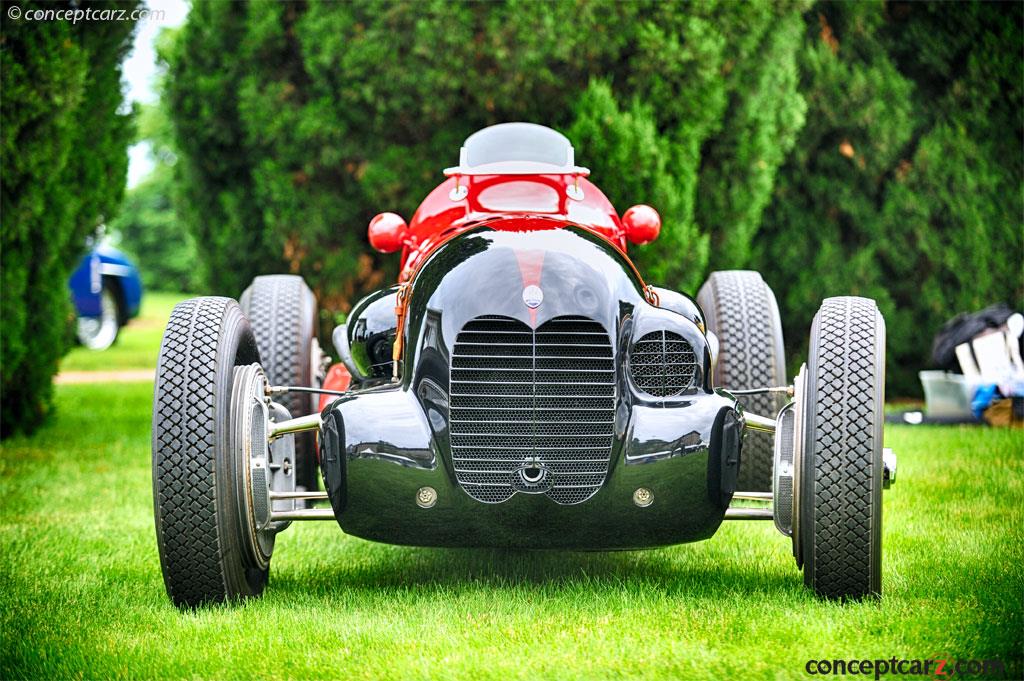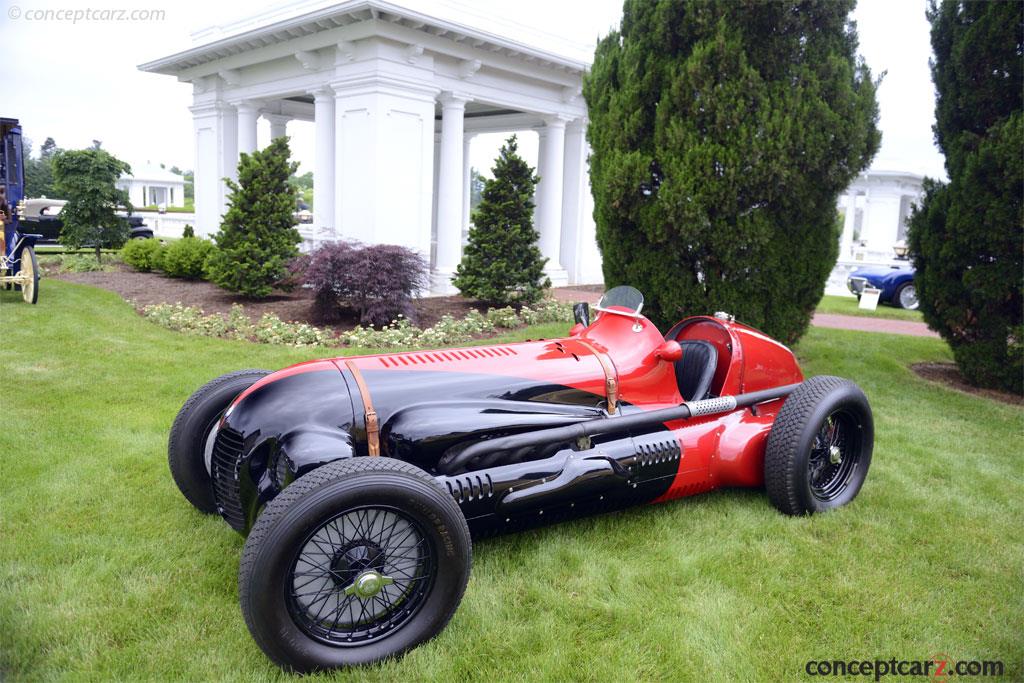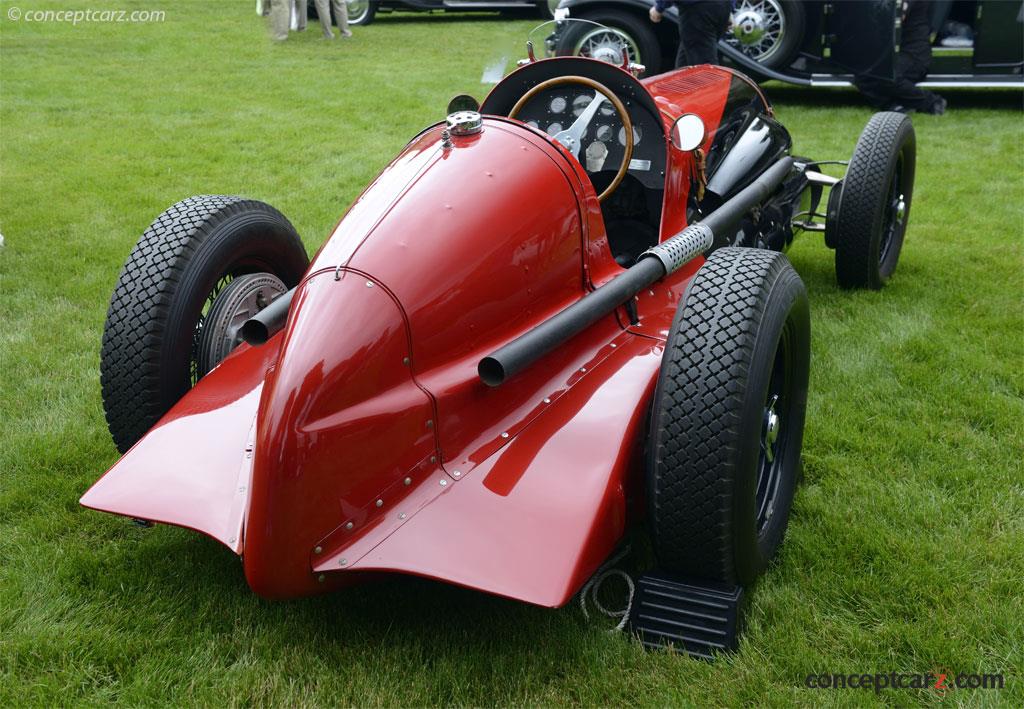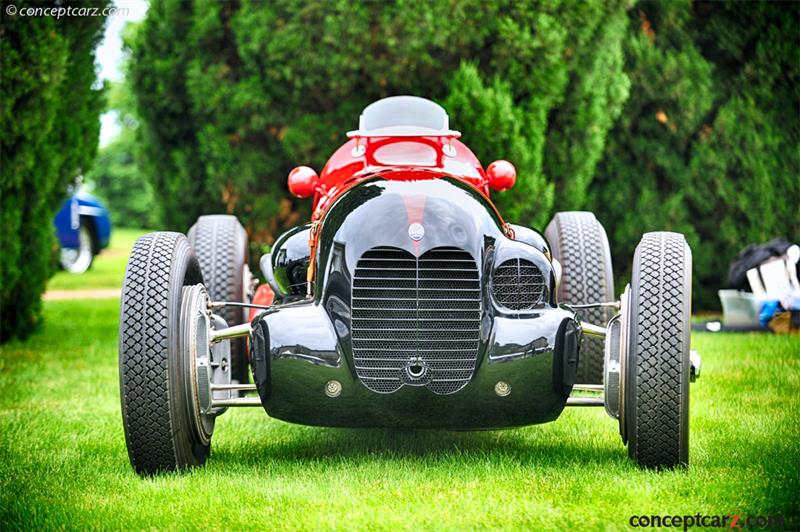The 8C 3000 Grand Prix cars were campaigned in the 1932 and 1933 season with one highlight being the French Grand Prix at Monthelery in 1933. The straight-eight engines initially produced around 220 horsepower. Two 8C 3000 Grand Prix cars were created, both were factory Works racers. An additional two engines were created; one was placed in a Bugatti Type 35 chassis and the other was used in the T.A. chassis.
Racer
Chassis #: 4504
View info and historyThe 8CM would become the replacement for the 8C 2800 and 8C 3000 Grand Prix cars. To get the most power possible from the engine, a Roots-Type supercharged was fitted. Power would eventually rise to around 280 bhp.The competition for the 1934 season continued to escalate, with the birth of the Mercedes-Benz Silver Arrow legends. The Mercedes-Benz W25 alone would score 16 victories in Grand Prix events as well as other major races. The Auto Union car would also be very successful, winning 32 of 54 races up to the end of 1937. Names such as Hans Stuck, Bernd Rosemeyer and Tazio Nuvolari are inseparably linked wîth the Auto Únion Silver Arrows. The cars were becoming incredibly fast and to make the sport a little safer, new for 1934 rules dictated a maximum dry-weight of 750 kg. The costs significantly increased as manufacturers sought exotic materials. 
Racer
Chassis #: 4504
View info and historyMaserati's 8CM was no longer competitive. In response, the Maserati brothers began work on a new car for 1935. It was given a V8 engine which was different front Maserati's earlier designs which used inline four, six and eight-cylinder configurations. Also different than prior designs was that each bank featured a single overhead camshaft, driven from the crankshaft by gears. It had a 3.3-inch bore and a 4.3 inch stroke, resulting in a 292.2 cubic-inch displacement size. With the help of a Roots-Type supercharger, the engine produced around 300 horsepower. The powerplant was mated to a four-speed mnaual gearbox and hydraulic drum brakes could be found at all four corners. An independent suspension setup was used in both the front and back with double wishbones and torsion bars in the front and rear swing axles and semi-elliptic leaf springs in the rear. The chassis was comprised of a steel boxed section frame and cross-members and clothed in an aluminum body. The gearbox was mounted in unit with the final drive. Maserati called its new race car the V8RI (representing Ruote Indipendenti or Independent Suspension). It made its racing debut in June of 1935 and by this point in the season, the teething problems and Achilles heels of the German cars had all been resolved. 
Racer
Chassis #: 4504
View info and historyFrenchman Philippe Etancelin drove the V8RI in its debut race to a second-place finish behind an Alfa Romeo in the first heat of the Grand Prix de la Marne at Rouen. During the feature race, the car retired prematurely due to engine problems. Its next appearance was at the Swiss Grand Prix 'Phi-Phi' where it crashed on the opening lap. The next race was the Italian Grand Prix. The Maserati brothers were able to get a second car ready for this event, where it was driven by Giueseppe Farina. Prior to the start of the race, however, the Farina's car developed an engine problem which left it on the side lines. The car driven by Etancelin was involved in an accident after the throttle was stuck. The Maserati V8RI raced a few more times during the season in minor events but the competition proved to be too much. Over the winter, two more examples were built with the first going to Etancelin. The car he had crashed at the Italian Grand Prix was rebuilt and given a revised rear suspension. A few modifications to the engine helped boost output to 320 bhp, which was still short of the German cars which were over 400 bhp. 
Racer
Chassis #: 4504
View info and historyFor the start of the 1936 season, Etancelin drove his new V8RI to a victory at the Pau Grand Prix. This would prove to be the highlight for the car, as much of the remainder of the season was plagued by reliability issues that hindered its ability to perform well. Not having achieved the desired results, Maserati decided to abandon the expensive program and focus on the more profitable 'Voiturett' class. Maserati would use the chassis design from the V8RI as the basis for the Voiturett cars and for the 8CTF which scored victories in 1939 and 1940 at the Indy 500.
by Daniel Vaughan | Jun 2018

Racer
Chassis #: 4504
View info and history

Racer
Chassis #: 4504
View info and history

Racer
Chassis #: 4504
View info and history

Racer
Chassis #: 4504
View info and history
by Daniel Vaughan | Jun 2018
1935 Maserati V8RI Vehicle Profiles
Recent Vehicle Additions
Related Automotive News

Sportiness In The Brand DNA: Game-Changer With Mercedes-Benz At Goodwood Festival Of Speed 2017
With a dozen racing cars and sporty vehicles from over 100 years, Mercedes-Benz Classic sums up the motto of this years Goodwood Festival of Speed Peaks of Performance – Motorsports Game-Changers celebrates competition vehicles that have written...

Dario Resta: A Man of Many Nations
Dario Resta would be born in August of 1882 in the Italian town of Faenza, not far from Imola. But though he would be Italian by birth, Resta would race under the Union Jack and the Stars and Stripes. It would not matter for what nation he drove, for...

120 years of motor sport at Mercedes-Benz take centre stage at the Goodwood Festival of Speed 2014
Addicted to Winning at this years Goodwood Festival of Speed, Mercedes-Benz looks back on some fascinating racing victories of the last 120 years
The unique motor sport heritage of the Mercedes-Benz brand is being celebrated with an exclusive i...

80 years ago: victory by the Mercedes-Benz W 25 in the International Eifel Race gave birth to the legend of the Silver Arrows
The silver-coloured body of the W 25 gave this nickname to the racing cars from Mercedes-Benz
Successful new development by Mercedes-Benz for the750-kilogram racing formula
Manfred von Brauchitsch drove the W 25 to victory and established a new tr...

Techno Classica 2014: more than 30 racing cars to celebrate 120 years of Mercedes-Benz motor racing history
Cars that were the heroes of magical moments put their stamp on this high-powered, most comprehensive show presentation
With more than 30 vehicles, Mercedes-Benz Classic presents motor racing history in all its unique breadth and depth
120 years o...













